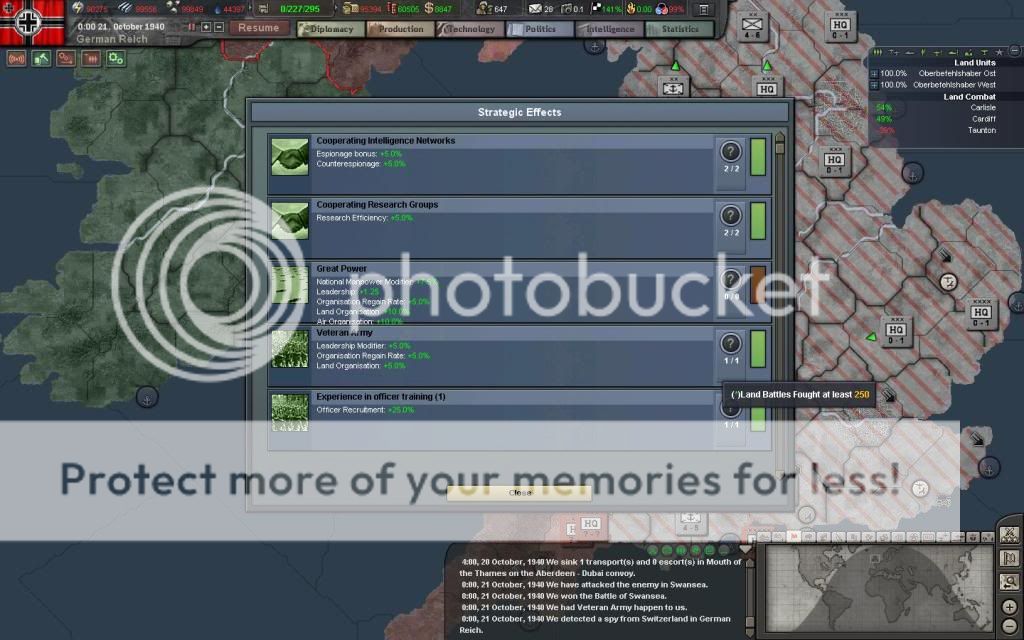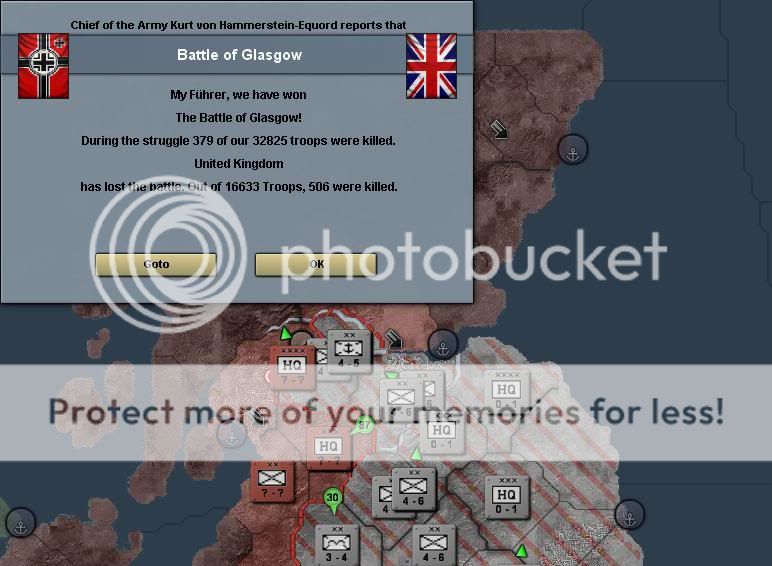Chapter 21: Weeks 17-27 - Fall of Wales and England, Scottish Resistance
On October 21, the Heer had fought over 250 battles. At this point, the combined battle experience meant that the Heer's officers and leaders were vastly superior to those of any other nation, and as a result future officers would receive better training faster, allowing their units to fight longer and recover from battle faster.
 The Reich's army has proven itself to be a cut above the Allies
The Reich's army has proven itself to be a cut above the Allies
A few days later, on October 24, the RN fleet led by Admiral Mountbatten, stationed at the besieged port of Cardiff, attempted to flee to France. When the Siege of Cardiff began two days earlier, Admiral Raeder positioned his fleet in the Bristol Channel, waiting for Mountbatten's attempt to escape. Mounbatten was desperate and lacked the munitions to fully fight. However, the RN's battleships were still powerful opponents, and managed to secure hits on the KMS Karlsruhe, KMS Königsberg, and a destroyer. Mountbatten returned to Cardiff after losing two destroyer flotillas, and Raeder immediately resumed the blockade.
 The First Battle of Bristol
The First Battle of Bristol
One day later the fleet, led by Admiral Pound now, attempted another escape, and managed to break through after 30 French submarines joined the battle. Mountbatten fled south, losing another destroyer flotilla in the process. Raeder immediately pursued.
 The Second Battle of Bristol
The Second Battle of Bristol
Raeder's faster, more modern fleet quickly caught up to Pound, who was joined by 30 RN submarines and 25 French destroyers. CAG's from the KMS Jade quickly sunk the HMS Hermes, eliminating the Allied air support. After the Herme's sinking, the Allied vessels scattered in a route, allowing aircraft from the KMS Jade and KMS Seydlitz to sink 20 submarines and 5 more destroyers. With the battle resulting in a sound victory, Raeder headed back to Amsterdam to repair the 2 damaged light cruisers and the KMS Deutschland, who suffered damage from the HMS Royal Oak.
 Admiral Raeder scores another victory
Admiral Raeder scores another victory
By November 2, Wales and England, with the exception of some holdouts in Newport, were under full German occupation. Panzerarmee 1, which had pacified both areas, were ordered to help Armee 1 break through the Scottish defenses. The mountainous terrain, coupled with cold weather and frozen ground, stalled the Heer's advance. Glasgow was taken on November 9 by the marines, but the front stalled due to poor weather.
 The status of the invasion on week 10
The status of the invasion on week 10
 Glasgow is taken by the Reich's marines
Glasgow is taken by the Reich's marines
On November 28, due to the large concentration of Allied naval vessels docked in ports along the French side of the English Channel, and the poor progress in Scotland, Panzerarmee 1 was recalled to Holland, and the planned invasion of France would begin without initial support from landings based in England. Three paratrooper divisions had finally completed pacifying the 3 garrison and 2 motorized holdout divisions in Newport, and were recovering and preparing for their role in the coming invasion.
 The status of the invasion on week 14
The status of the invasion on week 14
On December 4, Raeder once again set out, but this time to attempt to clear the English Channel of Allied patrols. The Allies had learned from their previous engagements, and all of their patrols had at least one carrier and at least 2 battleships. The Kriegsmarine's submarines were taking heavy damage from the constant air patrols, and were recalled to Wilhelmshaven for repairs. It was during this situation that Raeder came into contact with two Allied fleets, surprising them both due to the late hour. The RN's Admiral Cunningham took the lead on the Allied side, and Admiral Raeder once again led Flotte 1. The fighting was intense, and due to the stand-off nature as a result of the carriers, fighting lasted for 6 hours. The KMS Seydlitz was hit by a bomb from a plane based from the HMS Argus, while the KMS Admiral Scheer (replacing the damaged KMS Graf Spee), the KMS Leipzig and KMS Nürnberg (replacing the damaged KMS Karlsruhe and KMS Königsberg), and a destroyer received hits from the Allied destroyers and aircraft.
 The Battle of the Eastern English Channel
The Battle of the Eastern English Channel
With no German losses and 10 Allied destroyers sunk, Hitler finally realized that the naval aspect of the war would be won through attrition, and not the decisive battles he hoped for. However, despite Raeder's pleas to the contrary, Hitler still advocated building the remaining battleships. His reasoning, was that the nature of naval battle had changed from decisive engagements between capital ships to stand-off engagements between carriers. Because battles now began at much longer distances, each fleet's surface ships had to race to their opponents before being sunk by the aircraft. To Hitler, this explained why the KMS Bismarck and KMS Tirpitz accounted for 55% of all sunk ships, the vast majority of ships sunk by the pair being destroyers and light cruisers. To Hitler, this made sense. The faster screens would close into the battleship's range first, and were more likely to be sunk by the battleships than the CAGs and Kriegsmarine screens. The CAGs would focus on enemy carriers and capital ships first, which explained why the only three Allied capital ships sunk by the Kriegsmarine were sunk by planes based off of the KMS Jade and KMS Seydlitz.
To further reinforce this fact, the surface raiders sunk 76 convoys during this time period, 15 of them by the combined KMS Scharnhorst/KMS Admiral Hipper fleet operating near the Azores. That averaged to about 8 convoys sunk a week, down from the average of 11 from earlier in the war. There were several reasons for the decline in sunk convoys. The primary reason was the UK's loss of most of its ports, causing the trade routes to change. The raiders were slow to compensate, and as a result were hunting in areas now devoid of merchant shipping. Another reason was that France, Canada, and South Africa could not replace convoys faster than they were being sunk, as the vast majority of sunk merchant ships were flying the Union Jack.
However, due to not having naval superiority, the Kriegsmarine could not conduct anti-submarine patrols. As a result, 15 German convoys heading to Britain were sunk by French submarines operating in the North Sea.
 The status of the invasion on week 17
The status of the invasion on week 17









